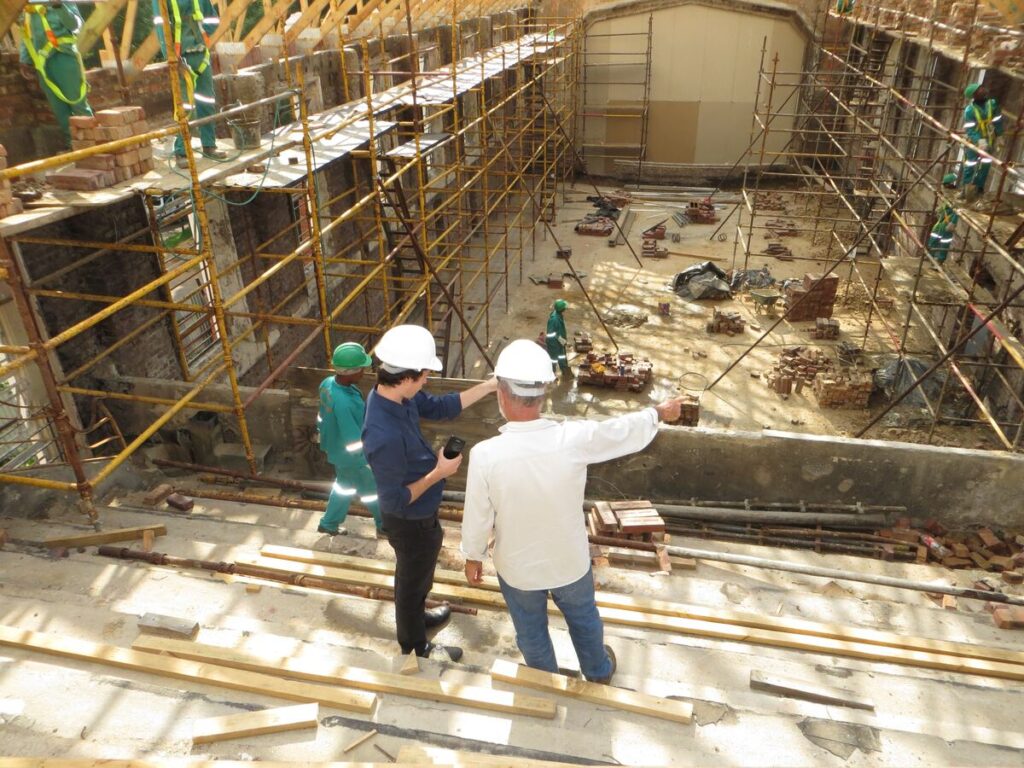Exclusive Neuroject Article: Construction planning represents a fundamental and complex task within the realm of construction project management. It encompasses various facets, including technological choices, defining work tasks, estimating the necessary resources and durations for individual tasks, and identifying interactions between different tasks. A well-structured construction plan forms the foundation for creating project budgets and schedules. Regardless of whether the plan is formally documented, its development holds significant importance in construction management.
Apart from the technical aspects, construction planning may necessitate organizational decisions regarding relationships among project stakeholders and the inclusion of specific organizations in a project. For instance, the extent to which subcontractors are involved in a project is often determined during the construction planning phase.
During the construction plan’s development, there is often a primary focus on either cost control or schedule control, as depicted in Figure 9-1. Some projects primarily categorize expenses with associated costs, making the planning process cost-centric. Within these expenditure categories, a distinction is made between costs directly linked to activity execution and those indirectly contributing to project accomplishment. Indirect costs, such as project financing interest and overhead expenses, are commonly considered in this context.
Alternatively, certain projects prioritize scheduling work activities over time, giving rise to a schedule-centric planning process. Here, planners ensure that activity precedence relationships are maintained, and available resources are efficiently scheduled. Traditional scheduling methods emphasize either maintaining task precedences (leading to critical path scheduling) or optimizing resource usage over time (resulting in job shop scheduling).
In complex projects, both cost and schedule considerations are imperative. Therefore, planning, monitoring, and record-keeping must encompass both dimensions. In such cases, integrating schedule and budget information becomes a major focal point.

Table of Contents
The Current Landscape of Construction Planning
In the year 2023, construction planning stands at the forefront of a dynamic and ever-evolving landscape. This planning process remains a crucial linchpin for ensuring that construction projects are not only completed within the stipulated timeframes and budgets but also meet the desired quality benchmarks. A comprehensive understanding of the current state of construction planning is imperative for industry professionals to effectively address emerging challenges and opportunities. In this discourse, we delve into the fundamental elements that define the landscape of construction planning in 2023.
1. Technological Progression
The continuous wave of digital transformation continues to reshape the construction planning arena. The widespread adoption of Building Information Modeling (BIM) has emerged as the norm, enabling the creation of intricate 3D models that enhance precision in planning, facilitate design coordination, and streamline clash detection. The integration of BIM with project management software has revolutionized communication among project stakeholders and elevated data-driven decision-making. Additionally, the utilization of cloud-based collaboration tools has substantially improved real-time communication and seamless sharing of information, thereby enhancing project coordination across geographically dispersed teams.
2. Integration of Sustainability
Sustainability has become an inherent component of the construction planning process. In response to escalating environmental consciousness and increasingly stringent regulations, construction planners are integrating green building practices, renewable energy solutions, and sustainable materials into their plans. Thorough sustainability assessments, life cycle analyses, and evaluations of carbon footprints have become standard considerations in construction planning, aligning projects with global environmental objectives.
3. Emphasis on Resilience Planning
The construction industry is actively responding to the challenges posed by the evolving climate. Resilience planning, which encompasses the assessment and mitigation of risks associated with extreme weather events and other climate-related factors, has gained prominence. Construction planners are now integrating climate resilience measures into their strategies to safeguard infrastructure investments against damage and disruption.
4. Prefabrication and Modular Construction
The adoption of prefabrication and modular construction techniques is on the rise. These innovative methods yield significant time and cost savings, as components are manufactured off-site and subsequently assembled on-site. Construction planners are adapting their approaches to accommodate these novel methodologies, which also contribute to waste reduction and enhance quality control.
5. Complex Regulatory Environment
Construction planners are grappling with an increasingly intricate regulatory landscape. The evolution of building codes, safety standards, and zoning regulations necessitates planners to remain meticulously informed and ensure project compliance with the latest legal prerequisites. Navigating this regulatory terrain requires precision and adaptability in the planning processes.
6. Workforce Challenges
The construction industry is contending with the dual challenges of labor shortages and an aging workforce. Construction planners must factor in these dynamics when devising schedules and allocating resources. The incorporation of automation, robotics, and artificial intelligence into planning is witnessing a surge in bridging the workforce gap.
7. Globalization and Supply Chain Considerations
While globalization has expanded the horizons of construction projects, it has simultaneously exposed them to supply chain disruptions and geopolitical risks. Construction planners must now account for these factors when procuring materials and orchestrating project logistics.
In summation, the contemporary landscape of construction planning in 2023 is characterized by technological advancement, an unwavering commitment to sustainability, resilience planning, and the ability to navigate intricate regulatory and workforce challenges. Adapting to these transformations and proactively incorporating them into construction planning processes is pivotal for the successful delivery of construction projects in the modern era. Construction planners who embrace these developments are well-positioned to mold a more efficient, sustainable, and resilient future for the industry.

Fundamentals of Construction Planning
The initial step in coordinating all project activities within a specified time schedule and budget is construction planning. The project team selects the strategies, guidelines, and tactics at this stage to realize its objectives. As a result, a construction plan serves as the main support for tracking and assessing all project-related activities.
What is construction planning?
Construction planning analyzes all required project operations, breaks them down into smaller tasks, and arranges them logically to determine the amount of equipment, people, and materials needed. The collection of documents created during construction planning is referred to as a construction plan. These are the available tools, tasks, timetable, and financial plan.
A construction plan may be undervalued by those outside the construction business, but it is the most economical way to successfully complete a project. The construction plan must be as thorough as possible because it serves as the standard for determining the project’s cost estimate and timing.
Why is Construction Planning Significant?
Construction planning is commonly defined as the process that steers a project from conception to its finalization. However, you might be curious about the actual purpose and benefits of a construction plan. There are several advantages associated with having a well-structured construction plan.
- Ensuring Timely Project Completion Within Budget Construction: A comprehensive construction plan outlines the necessary steps, work pace, sequencing, and methods to be employed. This ensures that the project is executed within the established timeframe and budgetary limits.
- Maximizing Productivity and Efficiency: Incorporating quality control measures within a construction schedule enhances overall productivity.
- Optimizing Time Allocation: A well-organized plan enables precise allocation of time among stakeholders, facilitating effective time management. This, in turn, minimizes the likelihood of project delays and budget overruns.
- Enhancing Safety and Procurement Processes: Effective planning allows for precise scheduling of purchases, streamlining the procurement process. Additionally, it contributes to improved safety by enabling the monitoring of on-site personnel and ensuring compliance with safety protocols.
Conversely, inadequate planning results in a lack of clarity regarding client expectations, leading to reduced productivity and inefficient work processes. Poor construction planning also often results in budget overruns, as the originally allocated budget proves insufficient to cover the project’s needs.
Key Elements of Construction Planning
Project Scope:
- Definition: This component involves the clear delineation of the project’s objectives, goals, and boundaries. It encompasses specifying both what the project aims to achieve and what it excludes.
- Significance: A well-defined scope acts as a safeguard against scope expansion, which can result in project delays and cost overruns. It also provides a precise direction for the project team.
Scheduling:
- Definition: Scheduling entails the development of a comprehensive timeline for project tasks and activities. It encompasses the sequencing of tasks, estimation of durations, and the establishment of significant milestones.
- Significance: A well-organized schedule ensures that tasks are carried out in the correct sequence and at the appropriate times, facilitating adherence to project deadlines.
Budgeting:
- Definition: In construction planning, budgeting involves the estimation of financial resources necessary for the project. This includes assessing costs related to materials, labor, equipment, permits, and potential unforeseen expenses.
- Significance: Accurate budgeting is fundamental in ensuring that the project remains within specified budget limits and that resources are allocated efficiently.
Risk Assessment:
- Definition: Risk assessment is the process of identifying potential risks and uncertainties that could impact the project. This encompasses evaluating the likelihood and potential consequences of each identified risk.
- Significance: Effective risk assessment aids in the development of strategies for risk mitigation and contingency planning, reducing the impact of unexpected events.

Role of a Project Manager in Construction Planning
A project manager assumes a central role in the construction planning process. Their responsibilities span various aspects of project management, including:
- Initiating the Project: The project manager commences the planning process by defining the project’s objectives, scope, and stakeholders. They articulate the project’s purpose and expected outcomes.
- Scope Management: The project manager ensures the precise definition and documentation of the project’s scope. They collaborate closely with stakeholders to establish unambiguous project boundaries and objectives.
- Scheduling: Responsibility for developing and maintaining the project schedule lies with the project manager. They compile task lists, determine task dependencies, allocate resources, and establish milestones for progress monitoring.
- Budget Management: Budgeting is a primary duty of the project manager. They assess costs, formulate a project budget, and oversee expenditures to guarantee the project’s fiscal viability.
- Risk Assessment and Mitigation: Project managers identify potential risks, assess their impact, and create risk management plans. They implement strategies to mitigate risks and effectively respond to unforeseen issues.
- Stakeholder Communication: Effective communication with stakeholders is paramount. Project managers facilitate regular meetings, furnish updates, address concerns, and ensure that all parties remain well-informed about project progress.
- Quality Assurance: Project managers establish and enforce quality control measures to ensure that the project conforms to specified standards and requirements.
- Resource Allocation: They are responsible for allocating and managing resources, including labor, equipment, and materials, to ensure adequate support for project tasks.
- Health and Safety Compliance: Ensuring worker safety and compliance with health and safety regulations is of utmost importance. Project managers supervise the implementation of safety protocols.
- Monitoring and Reporting: Project managers continually monitor project performance against the plan and report any deviations. They make necessary adjustments to keep the project on course.
The project manager serves as the linchpin in construction planning, responsible for coordinating and overseeing all facets of the project, from delineating its scope to managing resources and mitigating risks. Their leadership and managerial acumen are pivotal in ensuring the successful execution of the project within scope, budget, and schedule constraints while addressing potential challenges and risks.
Technology in Construction Planning
The construction planning landscape has been completely reshaped by technological advancements, ushering in an era characterized by enhanced efficiency, precision, and sustainability. Among these remarkable innovations, Building Information Modeling (BIM) stands out as a cornerstone of construction planning. BIM empowers architects, engineers, and construction experts to craft intricate 3D digital representations of buildings, inclusive of all their components and systems. This groundbreaking technology fosters collaborative design, detects clashes, and offers the foresight to address potential issues before construction commences. It simplifies the planning process, curbs errors, and ultimately leads to cost savings and quicker project completion.
Geographic Information Systems (GIS): The incorporation of Geographic Information Systems (GIS) has also had a transformative impact on construction planning. GIS technology empowers construction teams to scrutinize geographical data and spatial relationships, facilitating informed decisions concerning site selection, land utilization, and environmental consequences. This not only improves project planning but also guarantees compliance with environmental regulations and reduces the ecological footprint of construction projects.
Moreover, mobile applications and cloud-based project management tools have become indispensable tools for construction planning. These tools enable seamless real-time communication and collaboration among project stakeholders, regardless of their geographical location. Project managers gain access to crucial information, can closely monitor progress, and make instant decisions, leading to streamlined workflows and enhanced project coordination.
Artificial Intelligence and Machine Learning: The integration of artificial intelligence and machine learning into construction planning represents another exciting frontier. These technologies possess the capacity to analyze extensive datasets, including historical project data and weather patterns, to provide precise predictions regarding project timelines and budget requirements. By identifying potential risks and opportunities at an early stage, AI-driven systems empower construction planners to make data-informed decisions that elevate project outcomes.
Drones and Advanced Surveying Technology: The use of drones and advanced surveying technology has further modernized construction planning by delivering comprehensive and up-to-date site information. Drones are adept at capturing high-resolution images and swiftly generating topographic maps, facilitating accurate terrain assessments and meticulous construction activity planning. This not only bolsters safety but also contributes to improved resource allocation and project scheduling.
Technology has brought about a fundamental transformation in construction planning by fostering collaboration, boosting efficiency, and championing sustainability. Building Information Modeling, Geographic Information Systems, mobile apps, artificial intelligence, and advanced surveying tools have all assumed indispensable roles in contemporary construction planning, enabling projects to progress with greater fluidity and cost-effectiveness. As technology continues its evolution, the construction industry can anticipate a cascade of innovative solutions that will further elevate the planning and execution of construction endeavors.

Sustainable Construction Planning
Sustainable construction planning signifies a fundamental transformation in the construction industry, aiming to adopt ecologically sound practices that mitigate the adverse effects of construction on our environment. It transcends the mere act of building and instead focuses on fostering a sustainable future for our communities and the Earth. Here, we delve into the concept of sustainable construction planning within the confines of 350 words:
The bedrock of sustainable construction planning hinges on a paradigm shift. It acknowledges that buildings are not static entities but integral components of the ecosystem. As a result, the planning process encompasses the entire lifespan of a structure, spanning from its inception and construction to its ongoing operation and eventual dismantling or refurbishment.
Central to sustainable construction planning is a steadfast commitment to the efficient use of resources. This entails a prudent approach to materials and resources, minimizing waste generation, and exploring alternatives to conventional, resource-intensive construction methods. Sustainable planners prioritize materials with lower environmental footprints, such as recycled or locally sourced materials, while deploying construction techniques designed to curtail energy usage and reduce carbon emissions.
Energy efficiency assumes a pivotal role within the realm of sustainable construction planning. Given that buildings account for a substantial proportion of global energy consumption and greenhouse gas emissions, sustainable planners embed renewable energy sources such as solar panels and wind turbines into their blueprints. They optimize building orientation to harness natural lighting and heating and integrate energy-efficient technologies that trim energy consumption during both construction and day-to-day use.
Water conservation constitutes another vital facet of sustainable construction planning. Sustainable planners weave water-saving technologies like low-flow fixtures, rainwater harvesting systems, and greywater recycling into their designs to curtail water utilization in buildings. Such measures alleviate stress on local water resources and promote responsible water management.
Sustainable construction planning embodies a comprehensive approach to construction, emphasizing environmental stewardship, resource efficiency, energy conservation, and community well-being. Its aim is to alleviate the ecological and societal repercussions of construction while erecting edifices that symbolize a more eco-conscious, sustainable future. By infusing these principles into construction planning, we can diminish our carbon footprint, preserve invaluable resources, and construct a world that is more resilient and in harmony with the natural world. It’s not merely a trend; it represents the future of construction.
Challenges and Solutions
Construction planning is a multifaceted process fraught with its own set of difficulties. Nonetheless, with the right strategies and remedies, these challenges can be effectively tackled, resulting in more streamlined and prosperous construction projects.
1. Financial Restraints:
- Challenge: Staying within budget limitations is a frequently encountered hurdle in construction planning. Unanticipated expenses can rapidly inflate costs, leading to financial overruns.
- Solution: It is imperative to engage in precise cost estimation and continual monitoring. Employing advanced software for cost prediction and project oversight can help maintain expenses within bounds. Furthermore, having a reserve fund for unexpected outlays can mitigate budgetary risks.
2. Project Delays and Timing Challenges:
- Challenge: Delays in construction can be brought on by a range of factors, including adverse weather conditions, disruptions in the supply chain, or unforeseen site issues, all of which can have repercussions on project schedules.
- Solution: Leveraging sophisticated project scheduling software enables more precise tracking and adaptation of project timelines. Consistent communication and collaboration among stakeholders facilitate the identification and proactive resolution of potential setbacks.
3. Resource Management:
- Challenge: Effectively managing the allocation of labor, materials, and equipment can be intricate. Misallocation or underutilization of resources can lead to inefficiencies.
- Solution: The implementation of resource management tools can optimize resource allocation. Employing a just-in-time inventory system can curtail superfluous material costs, while the use of equipment tracking systems can maximize their utilization.
4. Risk Handling:
- Challenge: Construction projects inherently entail risks, ranging from design flaws to safety hazards.
- Solution: A comprehensive risk management strategy should be in place, encompassing risk identification, assessment, and strategies for mitigation. Regular safety training and strict adherence to safety regulations are crucial to minimize on-site hazards.
5. Adherence to Regulations:
- Challenge: Complying with local building codes, environmental laws, and zoning ordinances can be intricate and time-consuming.
- Solution: The engagement of experts well-versed in local regulations and maintaining open communication with regulatory authorities can ensure compliance. The use of technology for automated compliance tracking can also simplify this process.
6. Sustainability and Environmental Impact:
- Challenge: There is a growing emphasis on sustainable construction practices and the reduction of environmental footprints.
- Solution: The incorporation of sustainable design principles, utilization of eco-friendly materials, and the application of green construction methods can address these concerns. Certification programs such as LEED can guide sustainable construction practices.
7. Communication and Collaboration:
- Challenge: Effective communication and collaboration among various stakeholders, including architects, engineers, contractors, and subcontractors, are vital but can be challenging.
- Solution: The introduction of collaboration software and the cultivation of a culture of transparent communication can enhance teamwork. Regular meetings and status updates ensure that everyone is on the same page.
8. Technology Integration:
- Challenge: Implementing new technologies and ensuring their smooth integration into existing processes can be daunting.
- Solution: Workforce training and skill enhancement, along with a gradual adoption approach, can facilitate the transition to new technologies. The enlistment of experts or consultants for technology integration can also prove advantageous.
In summary, construction planning involves various challenges, but proactive measures and the adoption of contemporary technologies can help mitigate these issues. Effective financial management, scheduling, resource allocation, risk management, regulatory adherence, sustainability, communication, and technology integration are all pivotal aspects of successful construction planning. By addressing these challenges head-on, construction projects can progress more seamlessly and efficiently, delivering superior outcomes for all stakeholders involved.

Future Trends in Construction Planning
While the construction management sector had a positive start last year, the current market conditions indicate that the industry’s growth will be diverse due to global disruptions in the supply chain and inflation.
Key Insights
- The construction sector is still struggling with a shortage of skilled and high-quality labor.
- The conflict between Russia and Ukraine, along with economic sanctions on several countries, has disrupted supply chains and led to increased prices for commodities, contributing to a 40.5% rise in construction project input costs.
- The future of the construction industry will be characterized by environmentally friendly practices, with affordable options for efficient and sustainable building materials.
- Smart cities will attract significant investments, focusing on improvements in energy efficiency, public safety, security, and transportation.
- Modular and prefabricated construction methods will remain popular due to lower on-site expenses.
- The industry will increasingly adopt emerging technologies to streamline processes and reduce inefficiencies.
- As consumers become more environmentally conscious, there is an anticipation of more affordable sustainable buildings entering the market.
Construction Management Trends: What Lies Ahead?
The coming years will see technology taking center stage for most construction firms. Against a backdrop of geopolitical challenges, inflation, and disruptions in global supply chains, issues like the shortage of skilled labor and escalating material costs will persist.
Government regulations are poised to become stricter, driven by growing concerns about safety and climate change. Construction companies can mitigate risks and realize financial gains by streamlining operations and investing in innovative technologies and projects.
Workforce Shortage
The construction sector continues to grapple with a shortage of skilled workers due to a tight labor market. Persistent labor scarcities and high turnover rates can impede upcoming infrastructure and building ventures. This scarcity of labor is a result of declining interest in the field, an aging workforce, and the lure of technology and logistics sectors, which are competing for talent.
Escalating Material Costs
Another challenge confronting the construction landscape is the rapid surge in construction material prices. Geopolitical uncertainties, transportation bottlenecks, and the impact of COVID-19 have exposed vulnerabilities in construction supply chains.
Innovative Construction Materials
The future of construction technology appears promising with the utilization of advanced and long-lasting building materials. These alternative materials, now more affordable, offer sustainable choices for construction projects.
Smart Cities
Smart and sustainable cities continue to be in vogue, with tech giants such as Microsoft, IBM, and Cisco making substantial investments. The global smart city market reached $1,226.9 billion in 2022 and is projected to grow at a CAGR of 25.8% between 2023 and 2030.
Modular Construction and 3D Printing
Modular or prefabricated construction involves producing 60-90% of repetitive sections or modules offsite and then transporting them to the intended location. These prefabricated sections are assembled onsite through inter-module connections to form a building. This method gained traction, particularly with large projects demonstrating its feasibility.
Digitization and Technology Adoption
Although the construction sector has been slow in adopting digital technologies, future construction trends indicate a shift towards leveraging emerging technologies. Faced with increased competition, disruptions in global supply chains, soaring material costs, and labor shortages, businesses have had to embrace online technologies to cut costs and enhance profitability.
The following technology adoptions will gain prominence in the coming years:
- Digital Twins: These create real-time virtual construction models that aid informed decision-making. They simulate various scenarios to identify efficient construction methods while averting costly errors.
- Augmented Reality (AR): AR overlays data to enhance real-world perception. Team members can view job sites with additional information using AR-equipped smart devices, facilitating efficient project staging and preconstruction for clients.
- Building Information Modeling (BIM): BIM is a collaborative process that assists in planning, designing, constructing, and visualizing real-time changes using a single 3D model. It spans building management and operations for data-driven decision-making.
AI and IoT
Another emerging trend in the realm of commercial construction involves the utilization of artificial intelligence (AI) and the Internet of Things (IoT). Contractors are increasingly embracing a combination of these technologies to minimize losses and enhance operational efficiency.
Sustainable Building
As consumers place a growing emphasis on sustainability and global concerns about climate change continue to mount, the construction industry can anticipate incentives for the integration of sustainability principles into construction processes, designs, and projects.

Conclusion
Construction planning remains a dynamic field that adapts to meet the demands and opportunities of the modern age. It serves as the cornerstone for the success of construction projects, encompassing critical components like project scope, scheduling, budgeting, and risk assessment. The role of a project manager is pivotal in ensuring effective planning and execution, with responsibilities spanning from project initiation to resource allocation and risk management.
As of 2023, the landscape of construction planning is experiencing rapid change. Technological advancement, the integration of sustainability principles, resilience planning, and the adoption of innovative construction techniques are influencing the way projects are planned and carried out. Managing complex regulatory requirements, addressing workforce challenges, and considering globalization and supply chain factors are all integral aspects of construction planning.
Sustainable construction planning has emerged as an essential part of the industry, emphasizing eco-friendly practices, efficient resource utilization, and community well-being. It acknowledges the long-term environmental impact of construction and strives to minimize it through the use of sustainable materials, energy-efficient designs, and responsible water management.
Nevertheless, construction planning is not without its challenges. Issues such as financial constraints, project delays, resource management, and regulatory compliance require careful attention and proactive solutions. The adoption of technology, including AI, IoT, and BIM, is reshaping the construction planning landscape, offering opportunities for enhanced efficiency and decision-making.
Looking forward, the construction industry can anticipate ongoing growth and innovation, with a heightened focus on sustainability, digital transformation, and the development of smart cities. Adapting to changes in the workforce, navigating rising material costs, and complying with stricter regulations will be essential. By embracing these trends and addressing challenges proactively, construction planners can contribute to a more efficient, sustainable, and resilient future for the industry.
Resources:
Indeed | cmu | Sikich | SelectHub | OpticVyu | Hitachi Solution | Visilean | UK Connect | Device Magic | IntellectSoft | ProCore | ProEst | Deloitte | Construction Dive | KPMG
For all the pictures: Freepik | Unsplash



